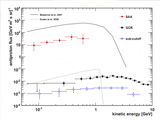|
|
TODAY.AZ / Weird / Interesting
PAMELA spacecraft finds a belt of antimatter around the earth
05 August 2011 [11:01] - TODAY.AZ
 You probably didn’t wake up this morning wondering what happens to the antiprotons that must be created by the collision of cosmic rays with the upper atmosphere. But if you are one of the few who loses sleep over the fact that these antiprotons should be somewhere out there but have yet to be directly detected, we are happy to report that you can rest easy: Astrophysicists have finally found them trapped in an antiproton belt around the Earth.
You probably didn’t wake up this morning wondering what happens to the antiprotons that must be created by the collision of cosmic rays with the upper atmosphere. But if you are one of the few who loses sleep over the fact that these antiprotons should be somewhere out there but have yet to be directly detected, we are happy to report that you can rest easy: Astrophysicists have finally found them trapped in an antiproton belt around the Earth.For those of you who couldn't care less about antiprotons or what an antiproton is, this is less a story about antiprotons or earth-shattering discovery and more a story about good science bearing fruit. See, when cosmic rays from the sun and elsewhere in the cosmos bombard nuclei in the upper atmosphere, the resulting particle collisions are akin to those that occur in particle accelerators here on the ground. And like those laboratory collisions, these smash-ups birth daughter particles.
Astronomers have long thought these collisions must produce antiprotons just as they do in the lab, but thus far no one has been able to prove definitively what happens to these antiprotons as they’re difficult to seek out and measure, especially from the ground. Theoretically it made sense that they should be trapped by the Earth’s magnetic field, yet no antiproton cloud was empirically evident.
Enter PAMELA, a low Earth orbiting spacecraft launched in 2006 to seek out antiprotons in cosmic rays. Each day PAMELA makes a pass through the South Atlantic Anomaly, the part of the Van Allen Belts that come closest to the Earth and a sort of tide pool for energetic particles. If the antiprotons are collecting anywhere, they ought to be here.
And now, after analyzing 850 days of data, it turns out they are. PAMELA tracked down exactly 28 of them, which is actually way more than one might expect to find blowing in the solar wind. In other words, antiprotons are being captured and stored there. Solid scientific theory (and high-tech orbiting hardware) wins again.
/Popular Science/
URL: http://www.today.az/news/interesting/92061.html
 Print version
Print version
Views: 2054
Connect with us. Get latest news and updates.
See Also
- 19 February 2025 [22:20]
Visa and Mastercard can return to Russia, but with restrictions - 05 February 2025 [19:41]
Japan plans to negotiate with Trump to increase LNG imports from United States - 23 January 2025 [23:20]
Dubai once again named cleanest city in the world - 06 December 2024 [22:20]
Are scented candles harmful to health? - 23 November 2024 [14:11]
Magnitude 4.5 earthquake hits Azerbaijan's Lachin - 20 November 2024 [23:30]
Launch vehicle with prototype of Starship made its sixth test flight - 27 October 2024 [09:00]
Fuel prices expected to rise in Sweden - 24 October 2024 [19:14]
Turkiye strikes terror targets in Iraq and Syria - 23 October 2024 [23:46]
Kazakhstan supplied almost entire volume of oil planned for 2024 to Germany in 9 months - 23 October 2024 [22:17]
Taiwan reported passage of Chinese Navy aircraft carrier near island
Most Popular
 What von der Leyen doesn't know about. Or doesn't want to know
What von der Leyen doesn't know about. Or doesn't want to know
 Culture Minister meets with Kyrgyz counterpart in Bishkek
Culture Minister meets with Kyrgyz counterpart in Bishkek
 Trump sees hope for Ukraine-Russia deal, analysts remain skeptical
Trump sees hope for Ukraine-Russia deal, analysts remain skeptical
 Uzbekistan, South Korea discuss easing visa rules, expanding seasonal work opportunities
Uzbekistan, South Korea discuss easing visa rules, expanding seasonal work opportunities
 Leyla Aliyeva visits school for visually impaired in Hanoi
Leyla Aliyeva visits school for visually impaired in Hanoi
 Pakistani PM hails Lahore-Baku direct flights as key milestone
Pakistani PM hails Lahore-Baku direct flights as key milestone
 Baku court resumes trial of Armenian-origin individuals accused of war crimes
Baku court resumes trial of Armenian-origin individuals accused of war crimes
